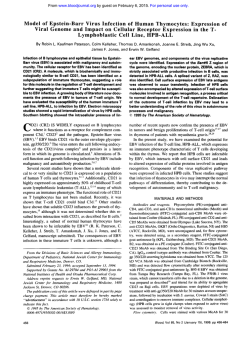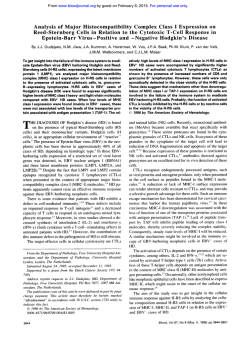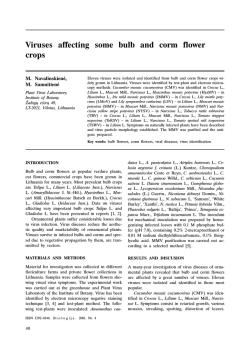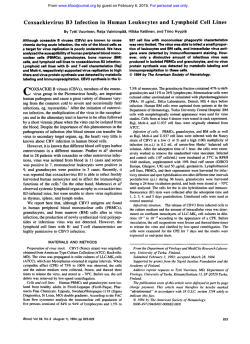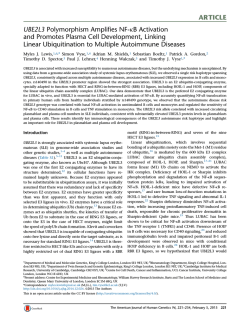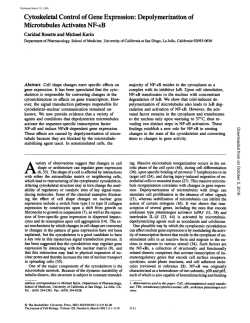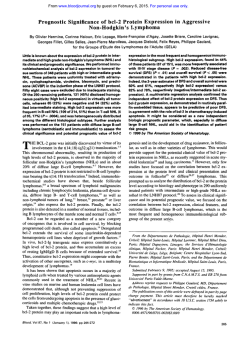
Deletion Variants Within the NF-KB Activation Domain of the
RAPID COMMUNICATION Deletion Variants Within the NF-KB Activation Domain of the LMPl Oncogene Prevail in Acquired Immunodeficiency Syndrome-Related Large Cell Lymphomas and Human Immunodeficiency Virus-Negative Atypical Lymphoproliferations By Hans Knecht, Martine Raphael, Cathy McQuain, Sylvia Rothenberger, German Pihan, Sophie Camilleri-Broet, Edith Bachmann, Glenn R. Kershaw, Shannon Ryan, Ellen L.W. Kittler, Peter J. Quesenberry, Daniel Schlaifer, Bruce A. Woda, and Pierre Brousset This sequencingstudy of 17 acquired immunodeficiencysyndrome-related lymphomas (9 primary brain, 8 systemic) and 8 human immunodeficiency virus-negative atypical lymphoproliferations expressing large amounts of the latent membrane protein 1 (LMP1) of Epstein-Barr virus was performed to characterize the carboxy terminal NF-KB activation domain of LMPl at the molecular level in an immunocompromised host. In-frame deletions within the NF-KB activation domain were identified in all but 2 primary brain lymphomas, 4 systemic lymphomas, and 4 atypical lymphoproliferations, ie, in 60% of cases.In addition, non silent point mutations (range 1 to 5, mean 3.3) were detected in all cases. Although all changes occurred within the first 100 nucleotides of the carboxy terminal NF-KB activation domain-a critical sequence for the protein half-life-not a single point mutation wasfound in theremaining 62 nucleotides, necessary for malignant transformation. Such a clustering of nonrandom sequence variations, associated with a high oncoprotein expression in immunocompromised hosts, suggests that this part of the LMPl oncogene behaves as a hypervariable region with natural selection of growth-promoting variants through prolongation of the protein half-life. 0 1996 by The American Societyof Hematology. L tinocytes,x inhibits human epithelial cell differentiation,’ induces DNA synthesis,” and upregulation of bcl-2 expression.” In transgenic mice, LMPl induces hyperplastic dermatitis and abnormal keratin expression.” Recent studies indicate that LMPl may stimulate intercellular and intracellular signal transduction pathways.” In particular, the membrane-spanning segments together with the carboxy terminal 55 amino acids of this oncoprotein are required for maximal stimulation of NF-KB, a transcription factor controlling the expression of genes involved in cell activation and growth c ~ n t r o l . ’ ~Stimulation .’~ of NF-KB activity appears to occur through phosphorylation and degradation of the inhibitory molecule IKBCX, followed by translocation of free NF-KB to the nucleus.I6 We recently reported in this journal the identification of clustered point mutations and deletions within that region of the oncogene in clinically aggressive cases of HIV-negative HD with high LMPl expre~sion.”,~~ High LMPl expression associated with bcl-2 oncoprotein expression in AIDS-related primary brain lymphomas (HIV-PBL) was just reported in the same forum.” These observations prompted us to test whether clustering of nonrandom point mutations within the NF-KB activation domain of the LMPl gene was a common findingin immunocompromised hosts. Overall, 17 AIDSrelated large cell lymphomas (including 6 brain lymphomas and 7 systemic large cell lymphomas [HIV-LCL] from ref 19) and 8 HIV-, LMPl-expressing atypical lymphoproliferations have been analyzed. Our findings show that a particular variant sequence of the NF-KB activation domain of the LMPl gene is predominant in EBV-related lymphoproliferative disorders in immunocompromised hosts. MP1, AN INTEGRAL membrane protein, encoded by the BNLFl gene of Epstein-Barr virus (EBV),’ is expressed in the multinucleated Reed-Stemberg (RS) cells of EBV-associated Hodgkin’s disease (HD), and in the immunoblasts of most acquired immunodeficiency syndrome (AIDS)-related large cell lymphomas and EBV-associated, human immunodeficiency virus (H1V)-negative, premalignant and malignant lymphoproliferative disorder^.^.^ A naturally occurring LMP-1 deletion variant (LMP1-del), characterized by mutational hot spots and a distinct 30-bp deletion within the carboxy terminal region, is identified in the same conditions.6 LMPl is considered to be a viral oncogene because of its capacity to transform rodent fibroblasts in vitro and torender them tumorigenic in nude mice.’ It transforms human keraFrom the LINK Laboratories at the Cancer Center, University of Massachusetts Medical Center, Worcester; the Service d’Hkmuiologie Biologique, Hdpital Avicenne, Bobigny, France; the Institute of Pharmacology,University of Lausanne, Switzerland; the Departtnent of Pathology, University of Massachusetts Medical Center, Worcester; the Laborutoire deNeuropathologie, INSERM U360, CHU Pitii-Salpe^triPre,Paris, France; and the Laboratoire d’Anatomie Pathologique, CHU-Toulouse, France. Submitted August 28, 1995; accepted November 14, 1995. Supported in part by the Swiss National Foundation (Grant No. 31-37727.93), the Recherche Suisse Contre le Cancer (Grant No. AKT 540); I’Agence Nationale de Recherche sur le SIDA, and the Fondution pour la Recherche Midicale (SIDACTION), France. Address reprint requests to Hans Knecht, MD, Division of Hematology/Oncology,University of Massachusetts CancerCenter, 55. Lake Ave N, Worcester, MA 01655-0246. The publication costsof this article were defrayed in part by page chargepayment. This article must therefore be hereby marked “advertisement” in uccordance with 18 U.S.C. section 1734 solely to indicate this fact. 0 1996 by The American Society of Hematology. 0006-497//96/8703-0047$3.00/0 876 MATERIALS ANDMETHODS Tissue samples,histology, and immunohistology. A survey of the origin of the 25 cases analyzed is presented in Table 1. Diagnosis of lymphoma or lymphoproliferative disorder was performed on 4pm tissue sections stained with hematoxilin-eosin. LMPl was de- Blood, Vol 87, No 3 (February l ), 1996:pp 876-881 LMPl DELETIONVARIANTS Table 1. Clinical and Histologic Data of the 25 LMP-1 Oncoprotein Positive Cases Cases Characteristics 1-9 HIV-associated primary large cell brain lymphomas. lmmunoblastic morphology, abundant LMP-1' tumor cells. HIV-associated large cell lymphomas without secondary brain involvement. Anaplastic large cell or immunoblastic morphology. Abundant LMP-1' tumor cells. H W lymphoproliferativedisorders Chronic lymphoproliferativesyndrome in a child. Few LMP-1' immunoblasts. JH and TCRP in germline configuration. Biclonal B-cell lymphoma after renal transplant in a n EBV- host. Angioimmunoblastic lymphadenopathy (AILD). JH and TCRP in germline configuration. T-cell lymphoma of AILD-type. TCRy rearrangement. T-cell lymphoma of AILD-type. TCRO rearrangement. AILD. LMP-1' B-immunoblasts. JH in germline configuration. Oligoclonal rearrangement of TCRP. Chronic lymphoproliferativesyndrome in a child from an HIV' mother. Oligoclonal rearrangement ofJH and TCRP. Hodgkin's disease. Splenic relapse with abundant LMPl + tumor cells. 10-17 18-25 18 19 20 21 22 23 24 25 817 IN AIDS-RELATEDLYMPHOMAS tected on deparaffinized 4-pm sections or fresh-frozen sections by incubation with monoclonal antibody cocktail CS1-4 (DAKO, Glostrup, Denmark) followed by identification of the CSl-4LMPl immune-complex with standard alkaline phosphatase-antialkaline phosphatase (APAAP) methods as previously described.2".21 The immunohistologic findings of cases 1,2,4-7, 10, and 12-17 have been reported previously." All these cases showed numerous LMPl-expressing tumor cells. In situ hybridization. In situ hybridization (ISH) for detection of intracellular EBV EBERl mRNA in histologic sections was performed with single-stranded digoxigenin-labeled RNA probes, complementary and anticomplementary (negative control) to EBERl mRNA transcripts as described p r e v i o u ~ l y . ~ ~ ~ ~ ~ Polymerase chain reaction (PCR). In all samples the LMPl genome was identified by PCR. Three different primer sets, specific for the carboxy terminal domain of the LMPl gene, were used. Detailed methods describing PCR conditions, amplification strategy, and primer sequences have recently been p~blished.~' DNA sequencing. All sequencing data are original and have not been published previously. Sequencing data of case 18 will also be published in a detailed clinical case report. Double-stranded PCR products obtained with the primer pair S'-AGCGACTCTGCTGGAAATGAT-3'/S'-TGA'lTAGCTAAGGCATTCCCCA-3' (primer pair 9/11 from ref 22) coding for regions adjoining the deletions were purified with a Geneclean I1 kit (B10 101, La Jolla, CA) and directly sequenced with "S dATP using a Sequenase kit (Amersham Life Sciences Inc, Arlington Heights, IL). Sequencing primers were MS1 (S'-ACAA'lTGACGGAAGAGGTI'GA-3'; nucleotide positions 168 358-168 338)" for the coding strand, and MS7 (S'-TCATCATCTCCACCGGAACCA-3'; positions 168 200-168 220) and primer 11 (S'-TGATTAGCTAAGGCATTCCCA-3'; positions 168 075-168 095) for the noncoding strand as reported.22From our previous experience6.17.18primer 11 yielded unambiguous sequencing results in all cases; therefore, this primer was used in all cases of this study. As an internal control, all brain lymphomas and three further cases were also sequenced with primer MS7. Primer MS I , including the mutational hot spot at positions 168 355-168 357, was additionally used in case 23 (eight point mutations, but none of them within the sequence needed for annealing of MSI). Controls. DNA from S2 EBV' nonmalignant conditions (17 cases offlorid infectious mononucleosis, 17 lymphoblastoid cell lines mainly from cancer patients, 11 reactive tissue lesions associatedwithEBV, 6 samples of peripheral blood mononuclear cells [PBMC] associated with inflammation, and PBMC from the EBV' healthy kidney donor of case 19) has been assessed for the presence of carboxy terminal LMPl deletions. In the case of the EBV-associated B-cell lymphoma of patient 19 the tumor occurred in a host without serologic evidence of EBV infection before the renal transplant, indicating that the origin of EBV in this patient was of donor origin. Statistical analysis. The x2 test with Yates correction was used to assess the association between LMPl deletions and malignant lymphoproliferation. RESULTS EBV genomes were detected by ISH, andhighLMPl expressionwasobservedwithin the immunoblastsofall cases. A comparative view of the sequencing data is given in Fig 1. Seven of 9 HIV-PBLs and half of the HIV-LCLs and HIV- LPDs showed LMPl deletions. All deletions and most point mutations were located within the first hundred base pairs of the carboxy terminal NF-KB activationdomain extending from nucleotide 168 324 to 168 225. Not a single point mutation occurred within the remaining 62 nucleotides from 168 224 to 168 163, identical with the 3' end of the LMPl coding region. Nonsilent point mutations were identified in 100% ofcases at position 168 225, in 88% at positions 168 308 and168 320, andin 84% atpositions 168 266 (mutation or part of the deletion) and 168 357 (no more in the NF-KB activation domain). Therefore, by far the most frequent sequence variation was characterized by non silent point mutations at positions 168 357, 168 320, 168 308, 168 266, and 168 225. The corresponding amino acid changes within the NF-KB activation domain are summarized in Fig 2. A high rate of mutationis seen within amino acid positions 332 to 338 (Fig 3), which are identical to the first six amino acids of the carboxy terminal region of the NF-KB activation domain. Interestingly, the 69-bp deletion originates also in this region. Overall, the same mutation pattern was observed in HIV-PBL, HIV-LCL, and HIV- LPD. In case 19 the posttransplant B-cell lymphoma occurred in a pretransplant EBV- host, indicating the donor kidney as a source of EBV infection. PCR-driven amplification of DNA extracted from donor PBMC using primers for the critical carboxy terminal region of the LMPl gene showed two bands migrating at 3 16 and 286 bp, respectively. Sequencing confirmed thepresence of the deletion variant identified in the B-cell lymphoma, but showed also presence of wild-type LMPl, notidentifiableinthetumor.Inthe 52 nonmalignant reactive conditions, carboxy terminal LMPl deletions were identified in 10 samples (19%). The presence of carboxy terminal LMPl deletions was significantly associatedwithmalignantlymphoproliferationscomparedwith 878 KNECHTET AL NF-KB activationdomain <""""""" ----------------> ! I trrrd rlrrcleutide HCI a Vs- P e BL: A G C 1 G 2 A G A 3 4-7 8 9 12 13 14 15 16 A LPD: I 1 7T C a s e 18 C 19 20,21 22 A T A A A G A G G G C G A A G 23 24 25 A A G T G I 1 I i T I : Cl T G A G G C T A G G G T T T C GT A G G I I C T C T T A A G G C C C CG C T C T T G G T C G C T C ] G A G A G A I I I I I T A A A A G A A A I I I I I I I f G O G A A A - _ _ _ _ _>- _ _ A G A f I B E A A A A A I I I I G C C C A A G f A G C ! ;T C T I A I <""""> <""""> <""""> <""""> T T ; <"""""""""""""""> A C A A G G A G G II T C <""""> <""""> <""""> C A ; ; A C <"""""""""""""""> II C T I I 10 11 H ICVa- sLeC L : C G G G 1 0 ! G <""""""- A G TC C A T T < <""""> G C T NF-KB activationdomain c ---------- Fig 1. Mutational hot spots within the NF-KB activation domain of the LMPl Oncogene in HIV-associated lymphomas and atypical lymphoproliferations.Point mutations inducing amino acid changes are in boldface type, silent mutations are underlined.Absence of letter indicates nucleotide identical to the wild-type sequence. Dotted lines indicate deletions of 69 and 30 bp, respectively. overall reactive conditions (P< ,001). Interestingly, in reactive conditions most LMPl deletions (6 of 17) occurred in the florid infectious mononucleosis cases. DISCUSSION The results of this study indicate that the carboxy terminal NF-KB activation domain of the LMPl gene expressed in AIDS-related primary brain lymphomas and disseminated lymphomas is characterized by the presence of a high number of nonrandom point mutations including distinct 30- and 69-bp deletions. This mutational patternwas previously identified in aggressive (relapsing) HD6,I7,l8atypical Bor T-cell lymphoproliferative disorder^,*^-^^ posttransplant lymphoma^,'^ and HIV-associated oral hairy leukoplakia.28 Our original observation of strong LMPl oncoprotein expression in such casesr7is now confirmed in a larger series because 13 of the AIDS-related lymphomas (6 primary brain, 7 systemic) molecularly analyzed in the present report have been shown to express LMPl oncoprotein at high levels when assessed by immunostaining." The identification of numerous tumor cells with a strong staining signal for LMPl appears to us indicative of oncoprotein expression at high levels because abundant LMPl mRNA transcripts have been identified in similar condition^.'^ Interestingly, this mutational pattern is found in a setting of profound T-cell anergy, ie, central nervous system lymphoma in AIDS patients, and of diminished T-cell-me- diated immunity, ie, angioimmunoblastic lymphadenopathy (AILD) and HD. The chief difference lies in the number of LMP1-expressing cells, which is very high in HIV-PBL and HIV-LCL, but small to intermediate in AILD and HD. However, when transformation of AILD into B-immunoblastic lymphoma occurs, abundant LMP1-expressing tumor cells are observed.26This pattern is best explained by the hypothesis that the mutations within the carboxy terminal domain of LMPl confer a growth advantage to lymphoid cells, still partially counterbalanced in AILD and HD by the host's immune response. A further decrease in cell-mediated immunity may then lead to an uncontrolled immunoblastic proliferation resulting in B-immunoblastic lymphoma or lymphocyte-depleted HD. Indeed, the outgrowth of the donor-derived LMPl deletion variant butnot of the donorderived LMPl wild type in the B-immunoblastic lymphoma of the initially EBV- host after renal transplantation (case 19) is consistent with a growth advantage of the LMPl deletionvariant over the wild type in the immunosuppressed host. Several recent findings are in favor of a natural selection process of LMPl deletion variants. First, all deletions and most amino acid substitutions are located within the carboxy terminal LMPl domain required for maximal NF-KB-mediated tran~cription.'~"~ Deletions and mutations are restricted to the first 33amino acids in this region, whereas not a single substitution is observed within the remaining 22 amino acids, a region that is necessary for transformation of Rat-l fibro- LMPl DELETION VARIANTS IN AIDS-RELATED LYMPHOMAS Wild r y e B95-8: crtr~irlo rrurrlkr acid desigrroriort nrrd HIV-PEL: Case 332 Gly 879 333 343 338 337 335 334 Asp Gln Gly Arg Atg Arg Thr Pro Leu 346 His Gly 1 2 3 4 -7 8 9 HIV-LCL: Case 1 0 11 12 13 14 15 16 17 LPD: Case 1 8 19 20,21 22 23 24 25 348 Ilk 352 His 355 Gly 356 361 Asp Tllr <"""""""> <"""""""> <"""""""> Ser Ser Ser His Ser Ser Ser S e t Arg Arg Arg Met Ala Thr Ala Thr 386 Ala Thr Thr Thr Thr Thr Ala Thr Thr Thr Tht Arc3 A s pA r g Arg Ser Ser <""""""""""""""""""""-> Asn <"""""""> <"""""""> <"""""""> <"""""""> Ser 366 Ser Met Met ArA g sp A r g Ser Arg Arg 362 Leu Tyr Ala Ser A s p A rAg s n Arg Arg A r gA s p Arg Arg Ser Ser Ser Ser Ser <"--""-"--", <"""""""> Arg Thr Thr Tht Thr Thr Thr Asn Arg Cys Arg Fig 2. Mutational hot spots within the NF-KB activation domain (aminoacids 332-386)of the LMPloncogene in HIV-associated lymphomas and atypical lymphoproliferations. Absence of amino acid designation indicates aminoacid identical to the wild-typesequence. Dotted lines indicate deletionsof 23 and 10 amino acids, respectively. blasts."" Such naturally occumng deletion variants (the most frequent variant as present in cases 4 through 7 was tested) maintain their transforming capacity when expressed in Rat1 fibroblasts.3r Furthermore, they are preferentially expressed in multinucleated RS cells with the same frequency as the wild-type LMPl when transfected into the EBV- HD cell line L-428.32 These data suggest that such LMPl-del variants maintain anoncogenic potential identical to the wild type. Second, such deletion variants may escape immunologically mediated elimination. It has been shown that theLMPl deletion variant NPC C A 0 (same point mutations and dele- G A T C 168 334 tion within the carboxy terminal NF-KB activation domain as observed in cases 4 through 7) is nonimmunogenic in a murine carcinoma model system, in contrast to the wild-type homologue B95-8." Third, the immunomodulatory properties of the LMPl-del variants may differ from the wild type because of a longer protein half-life. Mutations between amino acids 322 and 364, which encompass a critical sequence for the protein might lead to accumulation of LMPl. Considering the large amount of oncoprotein identified withinthe tumor cells of this series, it is reasonable to assume that a growth advantage of LMPl-del might result G A T C F i:f G G l C ARC TGG THR em GGC Pro G G A Pro G A T C / C T GA s p ' G ~ ARC C F G Asp GECARG C CG Gly G G C Pro G G A Pro C I GA S P GGC Pro C I A HIS G! SER 168298- 16 4 Fig 3. Mutational hot spots within the NF-KB activating domain of the LMPl oncoprotein of AIDS-related lymphomas. All tumors have large cell ~immunoblastic~ morphology and strongly express LMP1. Mutations are clustered between amino acids 333 and 338.The most frequent variant is shownin the center (cases 4 through 7 from Fig 2).Number 16 on the leftcorresponds t o case 2 of Fig 2. Number 6 on the right corresponds t o case 10 from Fig 2. KNECHT ET AL 880 from prolongationof the oncoprotein half-life. This basic mechanism which favors virus growth would also explain that identical carboxy terminal LMPl-del variants are observed in both strain A and B of EBV,25,35and that LMPldel variants are found in 30% to 35% of patients presenting with florid infectious m o n o n u c l e o ~ i but s ~ ~in~ only ~ ~ 10% of EBVC controls without clinical history of this disorder. ACKNOWLEDGMENT The authors thank Dr J. Sullivan, University of Massachusetts Medical Center, for PBMC of patients presenting with infectious mononucleosis. REFERENCES I. Fennewald S, van Santen V, Kieff E: Nucleotide sequence of a mRNA transcribed in latent growth-transforming virus infection indicates that it may encode a membrane protein. J Virol 51:41 I, 1984 2. Pallesen G, Hamilton-Dutoit SJ, Rowe M, Young LS: Expression of Epstein-Barr virus latent gene products in tumour cells of Hodgkin’s disease. Lancet 1:320, 1991 3. Carbone A, Tirelli U, Gloghini A, Volpe R, Boiocchi M: Humanimmv,:odeficiency virus-associated systemic lymphomas may be subdi.,ided into two main groups according to Epstein-Barr viral latent gene expression. J Clin Oncol 1 1 : 1674, 1993 4. Hamilton-Dutoit SJ, Rea D, Raphael M, Sandvej K, Delecluse HJ, Gisselbrecht G, Marelle L, vanKrieken JHHM, Pallesen G : Epstein-Barr virus-latent gene expression and tumor cell phenotype in acquired immunodeficiency syndrome-related non-Hodgkin’s lymphoma. Blood 82519, 1993 S . Joske DJL,KnechtH: Epstein-Barr virusin lymphomas: A review. Blood Rev 7:215, 1993 6. Knecht H, Bachmann E, Brousset P, Rothenberger S, Einsele H, Lestou VS, Delsol G, Bachmann F, Ambros PF, Odermatt BF: Mutational hot spots within the carboxy terminal region of the LMPl oncogene of Epstein-Barr virus are frequent in lymphoproliferative disorders. Oncogene 10:523, 1995 7. Wang D, Liebowitz D, KieffE:An EBV membrane protein expressed in immortalized lymphocytes transforms established rodent cells. Cell 43:831, 1985 8. Fahraeus R, Rymo L, Rhim JS, Klein G: Morphological transformation of human keratinocytes expressing the LMP gene of Epstein-Barr virus. Nature 345:447, 1990 9. Dawson CW, Rickinson AB, YoungLS: Epstein-Barr virus latent membrane protein inhibits human epithelial cell differentiation. Nature 344:777, 1990 10. Peng M, Lundgren E: Transient expression of the EpsteinBarr virus LMPl gene inhuman primary B cells induces cellular activation and DNA synthesis. Oncogene 7:1775, 1992 11. Henderson S, Rowe M, Gregory C, Croom-Carter D, Wang F, Longnecker R, Kieff E, Rickinson A: Induction of bcl-2 expression by Epstein-Barr virus latent membrane protein 1 protects infected B cells from programmed cell death. Cell 65:1107, 1991 12. Wilson JB, Weinberg W, Johnson R, Yuspa S, Levine AJ: Expression of the BNLF-1 oncogene of Epstein-Barr virus in the skin of transgenic mice induces hyperplasia and aberrant expression of Keratin 6. Cell 61:1315, 1990 13. Mosialos G, Birkenbach M, Yalamanchili R, VanArsdale T, Ware C, Kieff E: The Epstein-Barr virus transforming protein LMPl engages signaling proteins for the tumor necrosis factor receptor family. Cell 80:389, 1995 14. Mitchell T, Sugden B: Stimulation of NF-KB-mediated transcription by mutant derivatives of the latent membrane protein of Epstein-Barr virus. J Virol 69:2968, 1995 15. Huen DS, Henderson SA, Croom-Carter D, Rowe M: The Epstein-Barr virus latent membrane protein-l (LMPI) mediates activation of NF-KBand cell surface phenotype via two effector regions in its carboxy-terminal cytoplasmic domain. Oncogene 10549, 1995 16. Herrero JA, Mathew P, Paya CV: LMP-I activates NF-KB J Virol 69:2168, 1995 by targeting the inhibitory molecule IKBCX. 17. Knecht H, Bachmann E, Brousset P, Sandvej K,NadalD, Bachmann F, Odermatt BF, Delsol G, Pallesen G: Deletions within the LMPl oncogene of Epstein-Barr virus are clustered in Hodgkin’s disease and identical to those observed in nasopharyngeal carcin ma. Blood 82:2937, 1993 18. Brousset P, Schlaifer D, Meggetto F, Bachmann E, Rothenberger S, Delsol G, Knecht H: Persistence of the same viral strain in early and late relapses of Epstein-Barr virus associated Hodgkin’s disease. Blood 84:2447, 1994 19. Camilleri-Broet C, Davi F, Feuillard J, Bourgeois C, Seilhean J, Hauw J, Raphael M: High expression of latent membrane protein 1 of Epstein-Barr virus and BCL-2 oncoprotein in acquired immunodeficiency syndrome-related primary brain lymphomas. Blood 86432. 1995 20. Brousset P, Butet V, Chittal S, Selves J , Delsol G: Comparison ofIn situ hybridization using different nonisotopic probes for detection of Epstein-Barr virus in nasopharyngeal carcinoma and immunohistochemical correlation with anti-latent membrane protein antibody. Lab Invest 67:457, 1992 L, Odermatt B, 21. Vassallo J, Brousset P, KnechtH,Lamant Delsol G: Detection of Epstein-Barr virus in Hodgkin‘s disease. Applied lmmunohistochem 1:213, 1993 22. Knecht H, Bachmann E, Joske DJL, Sahli R, Emery-Goodman A, Casanova JL, Zilic M, Bachmann F, Odermatt BF: Molecular analysis of the LMP (latent membrane protein) oncogene in Hodgkin’s disease. Leukemia 7580, 1993 23. Baer R, Bankier AT, Biggin MD, Deininger PL, Farrell PJ, Gibson TJ, Hatfull G, Hudson GS, Satchwell SC, Seguin C, Tuffnell PS, Barrel1BG: DNA sequence and expression of the B95-8 EpsteinBarr virus genome. Nature 310:207, 1984 24. Sandvej K, Peh SC, Andresen BS, Pallesen G: Identification of potential hot spots in the carboxy-terminal part of the EpsteinBarr virus (EBV) BNLF-l gene in both malignant and benign EBVassociated diseases: High frequency of a 30-bp deletion in Malaysian and Danish peripheral T-cell lymphomas. Blood 84:4053, 1994 25. Miller WE, Edwards RH, Walling DM, Raab-Traub N: Sequence variation in the Epstein-Barr virus latent membrane protein I . J Gen Virol 75:2729, 1994 26. Knecht H, Martius F, Bachmann E, Hoffmann T, ZimmermannDR, Rothenberger S, Sandvej K,Wegmann W, Hurwitz N, Odermatt BF, Kummer H, Pallesen G : A deletion mutant of the LMPl oncogene of Epstein-Barr virus is associated with transformation of angioimmunoblastic lymphadenopathy into B-immunoblastic lymphoma. Leukemia 9:458, 1995 27. KingmaDW,Weiss WB, Jaffe ES, Kumar S, Raffeld M: EBV LMPl oncogene deletions: Correlations withmalignancy in EBV-associated lymphoproliferative disorders. Blood 84:644a, 1994 (abstr, suppl 1) 28. Berline JW, Penaranda ME, Lennette E, Greenspan JS, Palefsky JM: Latent membrane protein I sequence variation in EBV strains from hairy leukoplakia, in Pagano J, Rickinson A (eds): Epstein-Barr Virus & Associated Disease. Cold Spring Harbor, NY, 1994. p 127 29. Joske DJL, Emery-Goodman A, Odermatt BF, Bachmann E, Bachmann F, Knecht H: Epstein-Barr virusburden in Hodgkin’s disease is related to latent membrane protein gene expression but not to active viral replication. Blood 80:2610, 1992 30. Moorthy RK, Thorley-Lawson DA: All three domains of the LMPl DELETION VARIANTS IN AIDS-RELATED LYMPHOMAS Epstein-Barr virus-encoded latent membrane protein LMP-1 are required for transformation of Rat-l fibroblasts. J Virol67:1638, 1993 31. Rothenberger S, Martin J, McQuain C, Bachmann E, Quesenbeny P, Knecht H: Naturally occuring deletion variants within the growth transforming domain of the LMPl oncogene ofEBV influence the LMPl oncogene expression and colony formation. Exp Hematol 23:789, 1995 (abstr) 32. Knecht H, McQuain C, Rothenberger S, Drexler H, Martin J, Bachmann E, Kittler E, Odermatt B, Quesenbeny P: Expression of the LMPl oncoprotein in the EBV negative Hodgkin’s disease cell line L-428 is associated with Reed-Stemberg cell morphology. Blood 1996 (submitted) 33. Trivedi P, Hu LF, Chen F, Christensson B, Masucci MG, Klein G, Winberg G: Epstein-Barr virus (EBV)-encoded membrane protein LMPl from a nasopharyngeal carcinoma is non-immunogenic in a murine model system, in contrast to a B cell-derived homologue. Eur J Cancer 30A:84, 1994 34. Martin J, Sugden B: Transformation by the oncogenic latent membrane protein correlates with its rapid turnover, membrane localization, and cytoskeletal association. J Virol 65:3246, 1991 35. Sample J, Kieff EF, Kieff ED: Epstein-Barr virus types 1 and 2 have nearly identical LMP-l transforming genes. J Gen Virol 15:2741, 1994
© Copyright 2024

